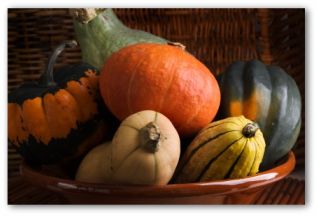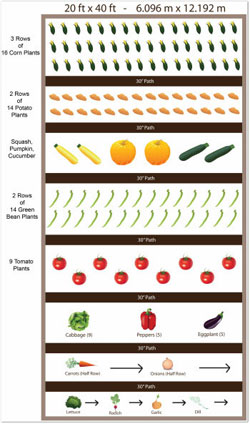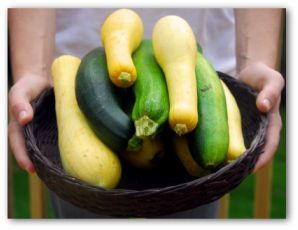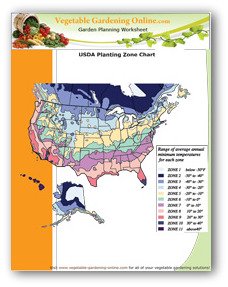Growing Squash of
Different Varieties

Check out our plans for growing squash including butternut and acorn squash!
How to grow winter and summer squash plants in your backyard garden.
Also learn how to grow pumpkins to be ready just in time for Halloween!
You will find planting squash including zucchini and yellow squash in your home vegetable garden is both fun and easy.
Design Your Own Vegetable Garden Layout Using our Free "Vegetable Garden Planner" Software!
Whether you are planning a small container or in-ground garden, or have plenty of room in your backyard, choose at least one of your favorite kinds of squash to plant in your vegetable garden layout.
Growing squash (acorn or butternut) is easy to do if you have a little extra room in your garden
Even a beginner at vegetable gardening should try their hand at growing summer squash such as zucchini,or winter squash and pumpkins.
Just be sure to leave plenty of room for your squash plants to grow unless you plan to train them to grow upward in what is called "vertical vegetable gardening"!
This tasty and nutritious member of the cucumber family grows in many delicious flavors, colors, shapes and sizes.
Download Free Garden Planning Worksheets, Garden Diary, Zone Chart, Or Planting Guide
Summer and Winter Squash Planting Information
Growing Zucchini and other Summer Squash
- Summer squash varieties such as yellow straightneck, zucchini, and scallop are harvested all summer until early fall. See seed planting instructions and spacing information below.
Growing Acorn, Butternut, Pumpkins and other Winter Squash
- Winter squash varieties like acorn, butternut, pumpkins and spaghetti are gathered near the first frost.
- The number of squash or pumpkin plants needed per person is 2-4 if you want enough squash to last all winter. If stored in a cool dry place, winter squash will last most of the winter.
- Seed germination is 5-7 days. Days to harvest from seeds in 40- 55.
Sow squash or pumpkin seeds or set transplants in prepared garden soil. Plant in rows or clusters of 3-4 seeds, in sandy loamy soil. The addition of organic matter such as compost improves water retention and adds fertility to the soil.
- Spacing in inches between rows of growing squash is 36-48. Space between plants is 24-36 inches at a depth of 1-2 inches.
Growing Squash in Container and Potted Gardens

Also, most kinds of squash or smaller pumpkins can be grown in a container or potted garden with a trellis provided for the vines to climb.
Simply fill a large 5 gallon container with potting soil, plant your squash seeds or seedlings, and add a cage or trellis immediately.
Choose smaller or dwarf varieties for container planting for best results.
Don't wait to add the trellis, as it is difficult to install a trellis once the plant plant has begun growing.
- To protect bees, which are needed to pollinate the crop, use pesticides only in the evening.
- Feed every few weeks to grow large productive summer or winter squash plants. Mulch the top of the soil one to two inches to conserve moisture.
Squash and Pumpkin Pests and Diseases
Major pests are caterpillars, powdery mildew, vine borers, and pickleworms. Check often for vine borers and pickleworms. Control pests by handpicking or spraying.
Water squash, zucchini and pumpkin plants in the morning so that the plant foliage is dry by evening. This will prevent powdery mildew from damaging squash plants.
If some of your yellow summer squash turns green with yellow spots this is caused by a mosaic virus attacking a few of the plants. The disease lives in the growing squash and may affect the color of both the leaves and the fruit.
The squash may be unappealing in appearance but is still edible.The only measure you can take is to remove the infected plants and try to eliminate the insects that carry the virus.
Squash is a favorite food of the pickleworm. With the tough skinned winter squash, caterpillars may not penetrate far and the wounds may heal. Summer squash is more vulnerable. Get a handle on pickleworm infestation early.
Insect eggs laid on growing squash foliage, flowers, and fruit hatch into destructive caterpillars. They immediately begin feeding and make holes in all parts of the plant. At harvest, it is most noticeable in the fruit.
Vegetable Garden Plan for Growing Zucchini and Pumpkins
Click Here for 20X40 Sample Vegetable Garden Plan
- Gardeners anticipating their first summer squash harvest must be patient.
- Early in the season, new hybrid varieties may produce an abundance of female flowers but no male flowers to pollinate them.
- Fruit may form but without pollination, it will remain small and appear to rot from the end.
- Male flowers will soon appear and with the aid of bees, the vines will begin producing.
Harvesting Squash and Pumpkin Plants
- At harvest time, acorn, butternut, and other winter squash varieties are best picked when young.
- Squash can be harvested as soon as fruit forms
but most are left to grow until 6-12 inches in diameter.
- Pick before the
skin toughens and the seeds grow large.
- Harvesting frequently keeps growing winter squash productive.
Summer Squash Harvest (Zucchini, Crook Neck)

A few fruiting vegetables are ready to eat at any stage of growth. Summer squash such as zucchini and yellow crook neck squash can be picked when the fruit first plumbs out. They are extra tender with small seed cavities. Small squash can be fried whole.
Winter Squash Harvest
Winter squash on the other hand, can be eaten when young but develops it's best flavor as the growing squash matures. When the skin becomes thick and hard the crop is ready to harvest. Winter squash may change color from a bright and shiny green to a dull green or to yellow or orange. Often fruit is only harvested as the vine begins to die.


